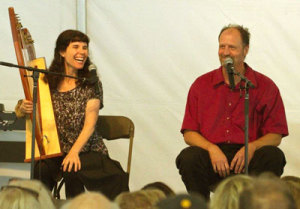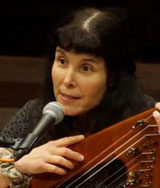
DIVING IN THE MOON:
HONORING STORY, FACILITATING HEALING
Social Work and Storytelling: Fusion for Healing
© Jeri Burns, MSW, Ph.D. 2014
Crazybowlz is a lovely restaurant in Kingston, NY. Boasting a unique menu of vegetables that are cooked to preserve freshness and avoid oil slicks, the food is also served in environmentally conscious containers. Healthy and green is good, but that isn’t the best part. The food at Crazybowlz is a collision of unexpected flavors, namely Asian-Mexican fusion. Catching the best of both worlds and integrating them in delicately spiced dishes, the chef creates meals that are at once delicious and guilt-free.
When fusion works, it is worth telling others about it.
Storytellers intuitively understand fusion, because that is how the folk process works. As traditional tales are passed from culture to culture, some bits of plot detail and setting are kept while others are changed to suit new audiences. As the story undergoes nuanced metamorphosis to reflect each culture it is told in, the bald essence of the root tale is preserved. That is why, over time and place and geographic distance, traditional stories are both recognizable and unexpected, like Asian-Mexican cuisine.
The folk process and fusion cuisine have a lot in common. In spite of the unexpected differences that erupt when integrating Asian and Mexican flavors, fusion cuisine is still food. Likewise, the folk process yields variants of tales that are still stories.
The world of therapy also understands the value of fusion, for the arts are often integrated in healing modalities. Art therapy, music therapy, and psychodrama are examples of how the arts are expressly used in healing. Similarly, when people tell their stories – in self-help organizations, the therapist’s office, or in facilitated group therapy sessions – the act of sharing and listening to such tales is an opportunity for healing. As storytellers already know, whenever and wherever stories are told, listeners glean images and messages that can help them navigate life’s journey. In sum, therapeutic techniques can include the arts and the arts can be therapeutic.
Fusion. The folk process. Integration. My work with The Storycrafters has also benefitted from these processes. Utilizing a central social work principle that forms and is formed by the foundation of social practice and ethics, my partner and I integrate it as the foundation of our storytelling with general audiences and in healing work.
When fusion works, it is worth telling others about it.
WHERE THE FUSION IS
 When storytellers compose their work and perform it, they think about their audiences. From a single listener to thousands, an audience can represent a variety of ages and cultural backgrounds. Knowledge about the audience helps to determine repertoire choices, language and phrasing, and the performance of the piece.
When storytellers compose their work and perform it, they think about their audiences. From a single listener to thousands, an audience can represent a variety of ages and cultural backgrounds. Knowledge about the audience helps to determine repertoire choices, language and phrasing, and the performance of the piece.
Social workers also focus on audiences. However the social worker’s audience is typically referred to as a client. A client can be an individual, a group, a family, or a community, and like storytelling audiences, clients represent a variety of ages and cultural backgrounds. Knowledge about the background and needs of a client affects what a social worker does with and for the client.
The storytelling and social work relationship between audience and client is exactly where fusion happens in my work. Given the similarities in the concepts of audience and client, for purposes of this article, the word “audience” and “client” will be used interchangeably and will be defined as those individuals, groups, or communities of people who are told stories for purposes of entertainment, education, and healing.
STARTING WHERE THE CLIENT IS
The social work tenet, starting where the client is, is often associated with Helen Harris Perlman. A social worker who wrote an influential text in the 1950’s called Social Casework: A Problem Solving Process,[i] Perlman made this concept social work’s headline. Translated to practice, social workers are non-judgmental when meeting clients. Through active listening and caring questions, they draw out their clients’ perception of their situations.[ii] This corresponds to flagship social work values which honor the dignity and uniqueness of every client and promote the practitioner-client relationship.[iii]
Starting where the client is is an assessment and relationship tool that empowers clients to be part of the solution by creating a duet of understanding between client and practitioner. It does not place the entire helping process in the hands of a social worker. As Dean Hepworth and his colleagues note, this conscientious consideration of the client remains throughout the practioner-client relationship.[iv]
STARTING WHERE THE AUDIENCE IS
Fusion. The folk process. Integration. This social work practice tenet starting where the client is translates beautifully to storytelling contexts.
Like most storytellers, my partner and I find ourselves in a huge array of settings with a great diversity of audiences. When we first arrive at the place where we will do a show, we have an idea about what stories we may tell. There is, however, active research to do before choosing the exact program. The success of storytelling, like the social work helping process, relies on the relationship between the audience and the storyteller. The responsiveness of the audience is dependent on what the performer does, and what the performer does is dependent on how the audience responds.[v] Like social workers who start where the client is, to respect and connect with our audiences, we start where the audience is.
When fusion works, it is worth telling others about it.
There are many paths to a good show. There are many paths to healing. It takes conscious vigilance to find the best path for each audience. Flexibility is required if taking a different path is what the audience needs. A distillation of the 5 steps we use to start where the audience is can be described by the acronym PATHS:
1. Place
2. Audience details
3. Time of day and year
4. Heed audience cues
5. Shift the path as needed
I will first describe how we do this with public audiences before illustrating how this approach translates to our healing work with psychiatric patients.
PLACE
We arrive well before our audience so we can learn all we can about the physical place where we will work. Our aim is to minimize distraction and create an ambient, comfortable space for storytelling and story listening. If the sound conditions are difficult, or if it is quite warm, for example, it can affect how the audience will take in our work. We adjust what we can and consider other conditions that could affect audience comfort. Are there visual distractions that might interfere? Can we rearrange the stage setup or audience seating to enhance intimacy? Learning all we can about the conditions of the place is vital to understanding how the audience might feel when they are there.
AUDIENCE DETAILS
We always investigate the makeup of our audience. For example, if we are performing in a school, we know the age range of the students in each assembly in advance. But we clarify this upon arrival in case of schedule changes. We also double-check the number of students who will be in the room and find out relevant cultural information about the makeup of the audience. All of this information guides us in the selection of story content and style of delivery. For instance, if there are a number of Latino students, we may choose to do one of our stories with Spanish language. If the age spread of the students is different than what we anticipate, that may warrant a different set of stories to meet the students where they are developmentally and socially.
TIME OF DAY AND YEAR
We take into account the time of day (early in the morning, students are likely to be quieter, later in the day they may be more roused). If it is the end of the day and the students are missing gym class, they are likely to be excitable and may struggle with a quiet, lyrical, listening story. Consideration of the time of year also matters. Students mature as the year goes on, thus changing how they respond to certain stories. Holidays and end-of-year excitement must also be factored into decisions for story selection in any show.
HEED AUDIENCE CUES
Every group is unique. Information gathered about an audience before they enter the space is useful as a preliminary guide only. Based on the social work idea of honoring individual differences from one client to another, we remain flexible and reserve decision-making about our program until we meet the students. We observe audience members when they walk in the room, seeking cues to their mood. As they settle in, we watch their body language and note their interactions with others. After we are introduced and begin the show, we usually do a test piece to learn more about their audience “personality” and their responsiveness (akin to a social worker asking questions and responding empathically to learn how the client perceives her situation), and we tell stories accordingly. These considerations, about where the audience is, continue all throughout the show, affecting every story we tell.
SHIFT THE PATH AS NEEDED
We usually have more material for every theme than can fit in a single show and thus have options in story selection. Although we are contracted for a particular show, our sponsors understand that we reserve the right to depart from the agreed upon theme if different material meets the audience better. Flexibility is key in this approach to our work.
Starting where the audience is with storytelling audiences in public performance venues has direct application to our work in the locked psychiatric unit where we are also privileged to work. When we tell stories in the intimate environment of a psychiatric ward, we approach the patients like we approach our general audiences, using the 5 step PATHS model.
PLACE
Our group at the hospital always occurs in the same activities room. Everyone sits around a long table. We make sure the chairs are spread around and that there is enough space for us and our instruments. Although the physical place doesn’t change from session to session, we still explore the atmospheric conditions of the space each time we meet. For example, open windows create a different mood than closed ones and a chilly room is hard on those patients dressed in hospital gowns.
AUDIENCE DETAILS

Prior to the start of our group, we meet with hospital staff to determine the mood on the ward and the census. We also find out if there are people on the unit whom we’ve worked with before. Most importantly, the staff informs us about the constellation of psychiatric issues that will be before us. Those issues affect the story choices and the way we tell them. We also discuss treatment topics that have been addressed in other groups so that our stories and/or language can reinforce them.
One of our sessions included a woman who was there for extreme depression after losing her only son. In consultation with staff, we decided to avoid stories about families, particularly parent-child relationships, and those that involved death. Depending on the nature of people’s psychoses, we generally avoid tales or language where characters hear voices or listen to dreams.
TIME OF DAY AND YEAR
Our sessions are always at the same time of day. However, patients are heavily medicated which can affect their ability to stay connected. It is also near discharge time, so we must expect sudden interruptions by hospital staff.
If it is close to holidays, this can have great bearing on everyone’s moods. Holiday times can be dark for those separated from friends and family and normal life. Sometimes the holidays are primary stressors causing a need for psychiatric care. Where one might consider telling holiday stories with other audiences to make a connection, telling them on a locked psychiatric ward is not necessarily a client-centered way to forge a connection with the audience.
HEED AUDIENCE CUES
We carefully monitor everything that we do in our sessions at the hospital. Our group isn’t large. It ranges in size from 6-15 at most. Like public performances, we do a tester story at the beginning to feel what the group is like. We vigilantly watch how each person listens, note emotional signals that suggest whether what we are sharing is difficult or just right. Keeping watch on all forms of body language is key here. The use of even a single word can trigger upset for anyone in the room, and that is why such vigilance is critical. Staying connected with the audience and gaining trust occurs when we respond to these cues.
SHIFT THE PATH AS NEEDED
All of this information gathering helps us choose our next story. We keep a list of about 40 stories on the table in front of us in case our intuition needs a jump-start. To be fully present for the men at women in the room, we shift from one story to another, or change language and images as needed.
By following PATHS, we start where the audience is. We modify the program as we go for 2 reasons: (1) to stay where the audience is and; (2) to honor the healing goals of the psychiatric staff.
THE MULLAH’S FLOWERS: An Example
In addition to impacting our story choices, knowing where the audience is can alter story structure and word choice. It can also affect the way we “perform” our tales (e.g.: adding participation, dropping repetitions, muting dramatic performance techniques). Using one story as an example, let’s walk through how this affects our storytelling at the hospital.
The Mullah Nasruddin is a beloved folk character in Islamic cultures and beyond. With different names depending on where he is found, such as Abunawas in Indonesia and Juha in Arabic speaking lands,[vi] he embodies the notion of the ridiculous and the sublime. Both wise and silly, his character provides enlightening views about philosophical issues through seemingly stupid action. His stories border on divine brilliance.
A quick perusal of the internet and folklore collections yields several variants of one traditional Mullah story.[vii] Below, I retell it in abbreviated fashion.
The Mullah Nasruddin planted a flower garden and was dismayed to discover dandelions growing there. He consulted gardeners who advised him of ways he could rid his garden of the hated flower. Every remedy was tried, every remedy failed.
 In desperation he went to see the Master Gardener. Discovering that the Mullah had tried every option that he knew, the Master Gardner sat silent. The Mullah was distraught.
In desperation he went to see the Master Gardener. Discovering that the Mullah had tried every option that he knew, the Master Gardner sat silent. The Mullah was distraught.
“Please, isn’t there something I can do?”
And the Master Gardener replied, “Well, yes, there is one thing you can do. You can learn to love dandelions.”
Instead of reviling life’s troublesome intrusions, the story suggests that we can embrace them instead. What a terrific healing message!
The first time I retold this story, it was a slightly longer version of the one you read above. And because I was attending to where the audience is (heeding audience cues), I saw something amiss. The clients’ body language told the story clearly: The Mullah tale ended too abruptly for many of the people in our audience
Continuing to monitor where the audience is, I thought more carefully about certain audience details (see PATHS above).
The patients we work with are in great distress, so much so that they are committed to a locked, psychiatric ward. Some are psychotic, some are profoundly depressed, some have substance abuse, anxiety, anger or other issues. Many patients have more than one issue and most are highly medicated. To say “just learn to love them” is a leap that many suffering people will be hard-pressed to make. To start where the audience is means we must eradicate the leap.
Thankfully, the creative muse was with me that day. I invented a mediating step on the way to ‘learning to love dandelions.’ A way to prepare the ground, it carries listeners more gently to the story’s message. For depressed people in particular, even tiny steps feel impossibly huge. What seems like a simple task to one person can feel monumental to someone suffering in the shadows of depression. The mediating step that I added makes the path to the story’s message a little more manageable for depressed listeners. It also provides excellent therapeutic fodder for people with other healing needs.
The Master Gardener continued.
“The dandelion is not what you expected in the garden. But think about this. It has leaves that are very nutritious. Its root has healing properties. This is a very special plant in your garden because it can offer food and healing.”
The Mullah nodded. Indeed, he could learn to love dandelions.
When I added that at the end of the tale, the nods and flickering eyes told me that this mediating step was exactly what they needed. The story spawned a terrific conversation about how we are the architects of our own perceptions. We also discussed how our perceptions of the world affect our responses. People with a variety of challenges, not only depression, related strongly to this. Our adaptations of this story now always include this mediating step.
ANOTHER APPLICATION
Sometimes when we visit the unit, our pre-group discussions with staff suggests that a theme about flexibility would be helpful for many. In that situation, we tell the same story another way.
The Mullah Nasruddin loved the color purple. One year, he decided to plant a perfectly purple flower garden. Every morning, it was his great joy to be greeted by his garden of purple floral perfection.
 One day, however, he was dismayed to discover a problem. A single, yellow dandelion marred the perfection of his garden. He plucked it out, but soon there were more and more yellow splotches ruining his purple perfection.
One day, however, he was dismayed to discover a problem. A single, yellow dandelion marred the perfection of his garden. He plucked it out, but soon there were more and more yellow splotches ruining his purple perfection.
The Mullah was distraught. He consulted many gardeners who advised him of ways he could rid his garden of the hated weed. Every remedy was tried, every remedy failed.
In desperation he went to see the Master Gardener. Discovering that the Mullah had tried every option that he knew, the Master Gardner sat silent.
“Please, isn’t there something I can do? Those terrible, yellow weeds are destroying my purple perfection!”
And the Master Gardener replied, “Well, yes, there is something you can do. Let’s look closely at one of the flowers that you call weeds.”
The Master Gardener pulled a dandelion from his own garden and showed the Mullah its secret.
“The leaves of this plant are delicious to eat and high in nutrition. The root has medicinal properties. Your weed is a food and a healing plant, a splash of sunshine in your purple perfection – if you choose to see it like that. You can learn to love dandelions.”
And the Mullah did. The next year, he planted a gloriously gold and perfectly purple garden of golden dandelions and purple flowers.
In our experience, this variation on the story brings up even more discussion. By making the first garden completely purple, a single yellow flower in that sea of purple is a clear and relate-able image to everyone. Listeners (and storytellers) dislike that rogue dandelion as much as the The Mullah and can, so it seems, better relate to The Mullah’s lesson from the Master Gardener.
However, we don’t always delve into the extremity of purple perfection, it depends on who is in the room and what their issues are. That is what starting where the audience is is all about. Tailoring stories to the audience is what makes them healing.
IN CONCLUSION
People benefit when they are met where they are. There is a time for formal presentations and a place where authority matters. But in social work and storytelling, mutuality and practitioner-audience relationship are critical to making the work work.
By adapting the social work tenet starting where the client is to storytelling, we start where the audience is and facilitate connections and good programming for all audiences, including those in healing contexts. There are many ways to make a storytelling program – when we start where the audience is, we are more likely to choose the best path for them.
Social work values and storytelling go together like dandelions and purples flowers, or even Asian and Mexican cuisine. When fusion works, it’s worth telling others about it.

 Jeri Burns, MSW, Ph.D., has worked for over 20 years with The Storycrafters, a renowned musical storytelling duo. In addition to their work in festivals, schools, and libraries throughout the US, Europe, and Caribbean, The Storycrafters are award-winning recording artists, radio show hosts, authors, producers of celebrated arts events, and recipients of NSN’s Oracle Award. Veteran arts educators, The Storycrafters have been consultants to the Cayman National Cultural Foundation in Georgetown, CI. They work collaboratively with dance companies and are on staff at Stamford Hospital’s Psychiatric wing where they conduct healing story sessions with inpatients. In addition to writing for The Storycrafters, Jeri does public radio commentary, communications coaching, and blogs at storytellingmatters.wordpress.com. In a previous life, Jeri did child welfare research and advocacy.
Jeri Burns, MSW, Ph.D., has worked for over 20 years with The Storycrafters, a renowned musical storytelling duo. In addition to their work in festivals, schools, and libraries throughout the US, Europe, and Caribbean, The Storycrafters are award-winning recording artists, radio show hosts, authors, producers of celebrated arts events, and recipients of NSN’s Oracle Award. Veteran arts educators, The Storycrafters have been consultants to the Cayman National Cultural Foundation in Georgetown, CI. They work collaboratively with dance companies and are on staff at Stamford Hospital’s Psychiatric wing where they conduct healing story sessions with inpatients. In addition to writing for The Storycrafters, Jeri does public radio commentary, communications coaching, and blogs at storytellingmatters.wordpress.com. In a previous life, Jeri did child welfare research and advocacy.
[i] Perlman, Helen Harris (1957). Social Casework: A Problem Solving Process. Chicago, IL: University of Chicago Press.
[ii] Hepworth, D., Rooney, R.,Dewberry Rooney, G., Strom-Gottfried, K., Larsen, J. (2010, 2006). Direct Social Work Practice: Theory and Skills. Belmont, CA: Brooks/Cole.
[iii] National Association of Social Workers Code of Ethics http://www.socialworkers.org/pubs/code/code.asp
[iv] Hepworth et al.
[v] The prominent folklorist, Richard Bauman, wrote a seminal paper that expanded the scope of folklore narrative study. Prior to his work, folklorists focused on the text of folk narratives alone. Bauman argued that the performance of that text, in context and with an audience, needs to be studied. He relates how there are linguistic and communication cues for both audience and storyteller that affect or enhance the meaning of the text. See Bauman, R. (1977). Verbal Art as Performance. Prospect Heights, IL: Waveland Press.
[vi] http://en.wikipedia.org/wiki/Nasreddin
[vii] There are many variants of this story on the web. Here are two: http://www.citehr.com/84862-story-mullah-nasruddin.html; http://dennislewisblog.com/2010/02/11/mullah-nasruddin-flower-garden/
